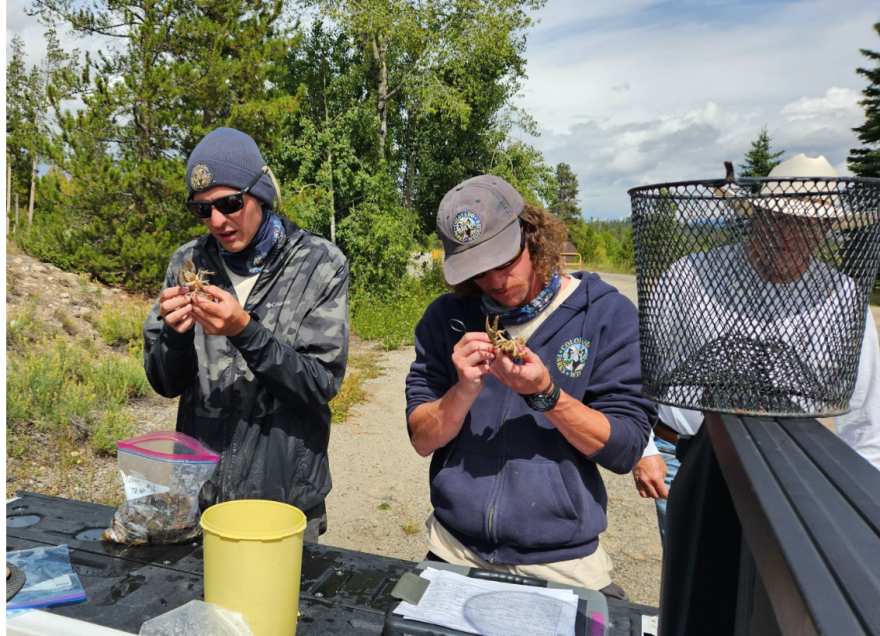Colorado Parks and Wildlife announced the discovery of an invasive crayfish species in Lake Granby. The rusty crayfish, named for reddish spots on its shell, hasn’t been seen in the state in over a decade. The agency is on high alert because of Lake Granby’s proximity to the Colorado River, and is now focused on stopping the crayfish from spreading further.
“They themselves are a very aggressive crayfish species, which leads to them outcompeting our native species for resources and also makes it so that they themselves are not a good prey species for our sportfish,” said Robert Walters, CPW’s invasive species program manager.
Walters said the invaders eat small fish, insects and fish eggs, which disrupts the aquatic food web. They can also eat plants on the bottom of the reservoir, which serve as critical habitat for fish spawning and food for native wildlife.
CPW believes rusty crayfish may have been brought to Lake Granby by an irresponsible angler using one as live bait. Crayfish are not legal as bait in Colorado. Crayfish of any species are not native west of the continental divide in Colorado, and CPW noted that all crayfish caught west of the divide must be immediately killed or returned to the water from which they were taken.
Crayfish have been top of mind for CPW lately. In August, the agency held a meeting to consider bans on the import and possession of live red swamp crayfish. That species, which is only native in states near the Gulf of Mexico, is popular for human consumption. According to CPW, thousands of pounds of the crayfish are illegally imported into the state each week, although none have been found in the wild.
Rusty crayfish, which are native to the Ohio River Basin, have only been recorded three times in Colorado. In 2009, the species was discovered in the Yampa River and Catamount Reservoir. The crayfish were seen in Sanchez State Wildlife Area in 2010, and in Stagecoach Reservoir State Park in 2011.
This most recent sighting is especially concerning to wildlife managers because of where the species was found. Lake Granby, which is near Grand Lake on the west side of Rocky Mountain National Park, is the third largest body of water in the state. Built in 1950, the reservoir helps store water from the Colorado River before it’s pumped underneath the mountains for use in cities on the northern Front Range.
That connectivity with the Colorado River is a red flag to CPW.
“Unfortunately, once they become established, there is very limited potential for eradicating them,” Walters said. “So really the goal at this point is to make sure that they don't get spread into other locations.”

Rusty crayfish sightings are relatively rare around the arid West. Wyoming wildlife officials are on high alert after clocking the region’s most rusty crayfish discoveries — 9 since 2003 — with the most recent coming in 2021. Data from the U.S. Geological Survey shows two 2016 sightings in Nevada, near Las Vegas, and one 1989 discovery in New Mexico.
The spread of rusty crayfish has been much more prevalent in the Midwest, where scientists have had more time to study their impact in regions where the species is considered invasive.
Rochelle Sturtevant, the program manager for the Great Lakes Aquatic Nonindigenous Species Information System, has studied the impact of rusty crayfish in parts of the Midwest. She called the species an “ecosystem engineer.”
“They’re kind of in this unique ecological niche where they can do some structural changes,” Sturtevant said. “The burrowers are getting down into plants, and once the plant community changes you kind of change everything.”
Sturtevant echoed the importance of stopping the spread of rusty crayfish.
“Our native Great Lakes crayfish don’t deal with them well at all,” she said. “They pretty much outcompete the natives wherever they show up.”
This story is part of ongoing coverage of water in the West, produced by KUNC in Colorado and supported by the Walton Family Foundation. KUNC is solely responsible for its editorial coverage.
CORRECTION: On Sept. 24, we incorrectly stated that there are no native species of crayfish west of the continental divide. There are no native crayfish west of the continental divide in Colorado, but there is at least one species of native crayfish in the Western U.S. This story has since been corrected.
Copyright 2023 KUNC




